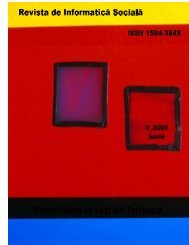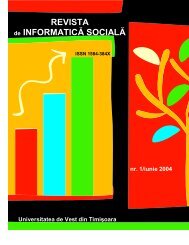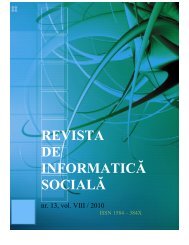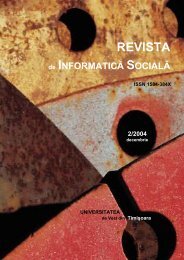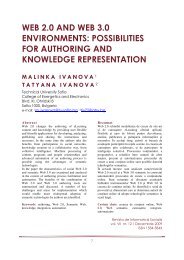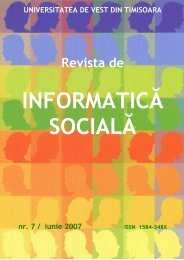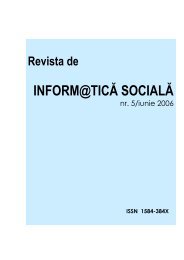Download - Journal of Social Informatics / Revista de Informatica ...
Download - Journal of Social Informatics / Revista de Informatica ...
Download - Journal of Social Informatics / Revista de Informatica ...
You also want an ePaper? Increase the reach of your titles
YUMPU automatically turns print PDFs into web optimized ePapers that Google loves.
eality. Besi<strong>de</strong>s being an additional incentive, these data have confirmed that our initiative to<br />
implement a collaborative learning platform was a good <strong>de</strong>cision.<br />
In Romania, the present period is <strong>de</strong>fined by attempts to change higher education into a more<br />
research and market based system as well as by the accomplishment <strong>of</strong> the transition to the more<br />
flexible Bologna system. In terms <strong>of</strong> critical competencies, early 21st century policies followed by<br />
our country state that “critical thinking, generalist (broad) competencies, ICT competencies<br />
enabling expert work, <strong>de</strong>cision-making, handling <strong>of</strong> dynamic situations, working as a member <strong>of</strong> a<br />
team, and communicating effectively” (Seitzinger, 2006) are required <strong>of</strong> active members <strong>of</strong> presentday<br />
society.<br />
Pioneering research and projects on the impact <strong>of</strong> Web 2.0 technologies in teaching/learning in<br />
Romanian secondary and higher education by our colleagues Gabriela Grosseck (West University<br />
<strong>of</strong> Timisoara), Carmen Holotescu (Polytechnic University <strong>of</strong> Timisoara), and Anisoara Pop<br />
(Dimitrie Cantemir University in Targu-Mures date back as early as 2003-2004. The results <strong>of</strong> their<br />
research in this area have been an encouragement for the authors <strong>of</strong> the present study and a sign that<br />
small steps taken in the right direction will finally cumulate in a critical mass that would <strong>de</strong>termine<br />
the long expected change, especially in terms <strong>of</strong> attitu<strong>de</strong> towards what currently is called “the<br />
learning revolution.”<br />
1.3. Language learning at tertiary level and Web 2.0 tools<br />
In language learning at tertiary level, the traditional teaching methods such as “presentationpractice-production,”<br />
followed by communicative, task-based, or project-based methods are<br />
gradually being replaced by a “post-method” stage (Harriman, 2010: pag. 78) where a prior analysis<br />
<strong>of</strong> the learning context, together with macro strategies such as maximization <strong>of</strong> learning<br />
opportunities, facilitating negotiation, fostering language awareness, promoting learner autonomy<br />
etc. (Kumaravadivelu, 2001, 2006, quoted in Harmer, 2007: pag.78) and reflective practice would<br />
ensure optimum results. This way, both teacher and stu<strong>de</strong>nts can participate in curricular and<br />
syllabus <strong>de</strong>cision, as well as in choosing the most a<strong>de</strong>quate/ efficient methods that take into account<br />
cultural, social and personal variables.<br />
Another factor to have played an important role in the change <strong>of</strong> paradigm in language teaching is<br />
the <strong>de</strong>velopment <strong>of</strong> digital literacy and <strong>of</strong> the view according to which, rather than simple assistive<br />
tools for transmission <strong>of</strong> information, technology-enhanced learning environments are conducive to<br />
higher cognitive performance. One <strong>of</strong> the foremost promoters <strong>of</strong> this paradigm shift, David H.<br />
Jonasen, claims that<br />
“Constructivist mo<strong>de</strong>ls <strong>of</strong> instruction strive to create environments where<br />
learners actively participate in the environment in ways that are inten<strong>de</strong>d to<br />
help them construct their own knowledge, rather than having the teacher<br />
interpret the world and ensure that stu<strong>de</strong>nts un<strong>de</strong>rstand the world as they<br />
have told them. In constructivist environments, like cognitive tools, learners<br />
are actively engaged in interpreting the external world and reflecting on<br />
their interpretations. This is not in the sense that learners actively<br />
listen and then mirror the one correct view <strong>of</strong> reality, but rather "active" in<br />
the sense that learners must participate and interact with the surrounding<br />
environment in or<strong>de</strong>r to create their own view <strong>of</strong> the subject”<br />
(Harriman, 2007)



